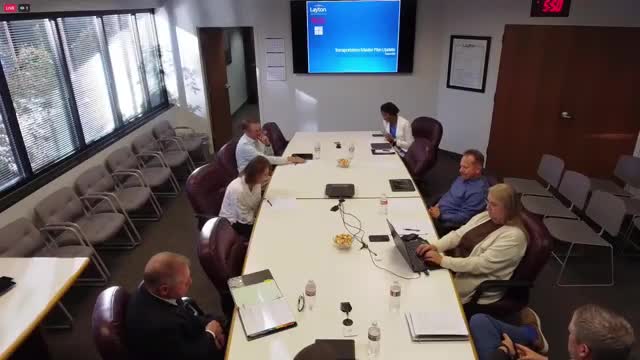Layton City Council adopts updated Master Transportation Plan, sets impact fees to take effect Jan. 5, 2026
October 03, 2025 | Layton City Council, Layton, Davis County, Utah
This article was created by AI summarizing key points discussed. AI makes mistakes, so for full details and context, please refer to the video of the full meeting. Please report any errors so we can fix them. Report an error »

The Layton City Council on Oct. 2 adopted a new Master Transportation Plan, an Impact Fee Facilities Plan and a Transportation Impact Fee Analysis intended to guide the city’s road and transit investments through 2034 and to 2050.
The plan, prepared by Wall Consultants Group with financial modeling by Zion Public Finance, updates Layton’s 2017 transportation plan, maps current and future congestion using regional travel-demand models, and lists priority projects in three phases. City staff recommended adoption and proposed the impact fees take effect Jan. 5, 2026 — 90 days after council adoption, to comply with state law.
City Engineer Steve Jackson told the council the package includes a story map for public access and that the plan balances “mobility and land access” by classifying streets from local to principal arterials, projecting future traffic, and estimating where intersections or widenings will be needed. The plan’s safety review examined five years of crash data and identified corridors where changes such as pedestrian-leading intervals or turn restrictions may improve safety.
The impact-fee analysis ties growth-related capacity projects to a fee charged to new development. The consultant calculated a per-trip cost of $173.37, and used that figure with Institute of Transportation Engineers trip-generation factors to produce maximum fees by land use (for example, the presentation showed a single-family dwelling fee around $1,600). The Impact Fee Facilities Plan lists roughly $71 million in 10-year capital projects, of which about $12.9 million were identified as impact-fee-eligible after accounting for anticipated outside funding.
Council members asked about funding gaps and long-term revenue. Jackson said the city will continue to pursue outside grants but noted some cities use a transportation utility fee to help pay for system upkeep and capacity; he also reiterated that impact-fee-eligible projects must be growth-related and comply with state rules on timing and permissible uses.
After public comment (a member of the public asked about coordinating utility upgrades with roadway projects), a motion to close the hearing and adopt Resolution 25-47 passed. Council members recorded votes during roll call in the minutes (Councilmembers Roberts, Morris and Smith Edmondson were recorded as voting “aye”), and the mayor announced the adoption was unanimous among those present. The council also directed staff to post the story map and plan documents on the city website for public review.
The new plan will be used to prioritize future capital projects, to coordinate with UTA and neighboring jurisdictions, and to set the schedule for impact-fee collection and use.
The plan, prepared by Wall Consultants Group with financial modeling by Zion Public Finance, updates Layton’s 2017 transportation plan, maps current and future congestion using regional travel-demand models, and lists priority projects in three phases. City staff recommended adoption and proposed the impact fees take effect Jan. 5, 2026 — 90 days after council adoption, to comply with state law.
City Engineer Steve Jackson told the council the package includes a story map for public access and that the plan balances “mobility and land access” by classifying streets from local to principal arterials, projecting future traffic, and estimating where intersections or widenings will be needed. The plan’s safety review examined five years of crash data and identified corridors where changes such as pedestrian-leading intervals or turn restrictions may improve safety.
The impact-fee analysis ties growth-related capacity projects to a fee charged to new development. The consultant calculated a per-trip cost of $173.37, and used that figure with Institute of Transportation Engineers trip-generation factors to produce maximum fees by land use (for example, the presentation showed a single-family dwelling fee around $1,600). The Impact Fee Facilities Plan lists roughly $71 million in 10-year capital projects, of which about $12.9 million were identified as impact-fee-eligible after accounting for anticipated outside funding.
Council members asked about funding gaps and long-term revenue. Jackson said the city will continue to pursue outside grants but noted some cities use a transportation utility fee to help pay for system upkeep and capacity; he also reiterated that impact-fee-eligible projects must be growth-related and comply with state rules on timing and permissible uses.
After public comment (a member of the public asked about coordinating utility upgrades with roadway projects), a motion to close the hearing and adopt Resolution 25-47 passed. Council members recorded votes during roll call in the minutes (Councilmembers Roberts, Morris and Smith Edmondson were recorded as voting “aye”), and the mayor announced the adoption was unanimous among those present. The council also directed staff to post the story map and plan documents on the city website for public review.
The new plan will be used to prioritize future capital projects, to coordinate with UTA and neighboring jurisdictions, and to set the schedule for impact-fee collection and use.
View full meeting
This article is based on a recent meeting—watch the full video and explore the complete transcript for deeper insights into the discussion.
View full meeting

